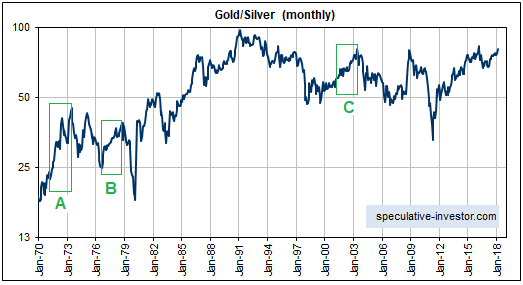It is widely believed that silver leads gold during bull markets for these metals. I wonder how this belief first arose and persists to this day given that it is contrary to the historical record.
It is partially true that silver outperforms gold during precious-metals bull markets. In particular, it’s true that silver tends to achieve a greater percentage gain than gold from bull-market start to bull-market end. It’s also the case that silver tends to do better during the final year of a cyclical bull market and during the late stages of the intermediate-term rallies that happen within cyclical bull markets. However, the early stages of gold-silver bull markets are characterised by relative strength in gold.
Gold’s leadership in the early stages of bull markets is evidenced by the following long-term chart of the gold/silver ratio. The boxes labeled A, B and C on this chart indicate the first two years of the cyclical precious-metals bull markets of 1971-1974, 1976-1980 and 2001-2011, respectively. Clearly, gold handily outperformed silver during the first two years of each of the last three cyclical precious-metals bull markets that occurred within secular bull markets.

Gold & Silver
Now, in the same way that all poodles are dogs but not all dogs are poodles, the fact that gold tends to strengthen relative to silver in the early years of a precious-metals bull market doesn’t mean that substantial strength in gold relative to silver is indicative of a precious-metals bull market in its early years. For example, there was relentless strength in gold relative to silver from mid-1983 until early-1991 that took the gold/silver ratio as high as 100, but there was no precious-metals bull market during this period.
Between mid-1983 and early-1991 there was, however, a multi-year period when gold, silver, most other metals and mining stocks offered very profitable trading opportunities on the long side. I’m referring to 1985-1987. We are probably in a similar period today, with the next buying opportunity likely to arrive before the end of this quarter.